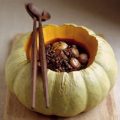A photo: Igor SavkinWe choose a lamb First of all, we will define the concepts. If you decide to cook a steamy leg of lamb, say, for the New Year, and not for Easter, then you should not even dream of a young lamb. The fact is that lambs are born after a five-month pregnancy only at the beginning of the year. In the Northern Hemisphere, this usually happens in January – March, and in the northern countries - closer to spring, which helps kids avoid the harsh conditions of winter. In the Southern Hemisphere, the cycle, of course, is reversed, so that in Australia and New Zealand lambs are born from September. Therefore, the meat of dairy lamb is a purely seasonal product. So, the choice is small: either you accept the fact that the leg of lamb bought on the market is about a year, two or even three (which, by the way, is quite good - lamb meat remains tender and tasty for up to three years), or you are looking for an Australian chilled lamb of two to three months of age (excellent, but expensive), or buy frozen leg without age. The defrosting technique for all of us, not spoiled with fresh meat, is well known: on the bottom shelf of the refrigerator, preferably in chunks of 450 g each, for 5 hours or at room temperature for about 2 hours. In the extreme case, if time is tight, you can put the meat under the stream of cold water, but this "breakthrough" will certainly affect the taste. Which meat should you prefer - young or adult? Nobody will definitely answer this question. Some prefer the most tender dairy lamb, others like the more characteristic meat of one-year-old lambs, and others give their hearts to mature lamb with a well-developed taste. The French, for example, appreciate mutton for its richness and brightness of taste, but you will not find any sheep older than two years in gourmet shops. One of the best in France is considered to be lamb from Poyak - now you can find it in our stores. The French call the leg of lamb a beautiful and musical word "gigot", apparently due to its similarity with the medieval stringed stringed instrument "gigot". Communication of food and music is symbolic - after all, we are preparing for the holiday! Lamb leg is usually cooked whole with bone. If you have “Manche-a-Gigot” in the kitchen cupboard - a special device that the sharp-witted French have invented for easy cutting of the finished leg, then it will be more convenient to screw it to the bone, if you cut the meat on the tibia bone with a knife and saw it off slightly higher the joint. In addition, the leg without the pelvic bone will be easier to cut into thin slices. Lamb and seasonings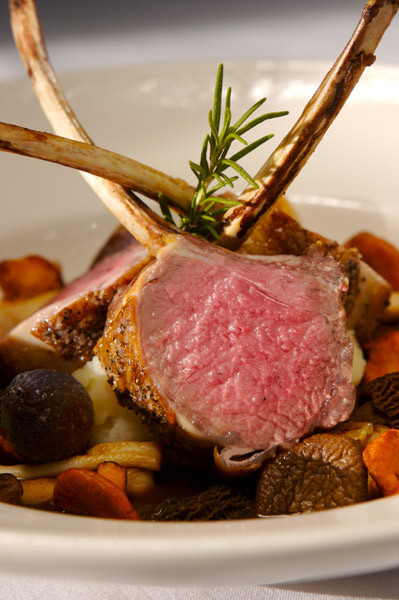 Recipes for lamb dishes Lamb fat is not the mosttasty in the leg, so it is better to cut off its accumulations. The dish will not have a specific lamb flavor if there are no films, excess fat, or veins left on the surface of the meat. Those who are worried about the unpleasant smell of lamb, just need to remember that there are seasonings and spices in the world. Any herbs from the labiate family go well with lamb - thyme (aka thyme), savory, marjoram and oregano. Try crushing dried herbs in a mortar with salt, pepper and a head of garlic, add a drop of white wine, mix and rub the leg with this spicy paste - not bad at all. The rather sharp smell of rosemary also harmonizes well with lamb, unless, of course, you get too carried away with this herb. The French, preparing one of the traditional dishes, “gigot with pistou”, cut a leg of lamb to the bone, fill the cut with pistou (a mixture of garlic, basil, parsley and bacon), sew the edges, grease with butter and bake in the oven. Fried potatoes are usually served as a side dish to this dish, and the leg is decorated with sprigs of rosemary. In the province of Bordeaux, “gigot à la Bordeaux” is made differently - they stuff it with bacon and anchovy fillets, pre-rolling them in parsley crushed with garlic and scallions, then tie them with twine, fry in a roasting pan in pork fat with onions, carrots and veal, and then stew for another hour and a half in wine. The finished leg is sliced and served with vegetables or potatoes. By the way, the great chef Alain Ducasse advises to be careful with garlic. He never stuffs lamb with it, but mashes a head of garlic, puts it in good olive oil, soaks the leg of lamb in it for two days, rubs it with herbs, of which he considers thyme and savory to be the most important (and not rosemary at all), and only then bakes it in the oven. But the English always serve a leg of lamb with mint sauce, which has obvious eastern roots. Continental Europeans are not known for this passion, for example, the French use this herb extremely rarely, but for the English, mint sauce and mint jelly are classic accompaniments to lamb. Perhaps we should also take English seasonings into service, fortunately, we have more than enough mint, and it, by the way, perfectly masks the taste of lamb fat. It is easy to make such a sauce - dissolve a couple of spoons of sugar in four tablespoons of boiling water, cool the syrup; pour 50 finely chopped leaves of fresh mint with wine vinegar, wait a few minutes and add sugar syrup. If before baking you marinate the leg for a couple of hours, for example, with garlic, rosemary and juniper berries, then it will acquire the taste of venison and accordingly will be called "gigot po-hunter". By the way, vegetable oil will not hurt, which can be greased on all sides of the leg (after marinating, of course) - the oil will not only give the meat additional taste and aroma, but also retain moisture during cooking.
Recipes for lamb dishes Lamb fat is not the mosttasty in the leg, so it is better to cut off its accumulations. The dish will not have a specific lamb flavor if there are no films, excess fat, or veins left on the surface of the meat. Those who are worried about the unpleasant smell of lamb, just need to remember that there are seasonings and spices in the world. Any herbs from the labiate family go well with lamb - thyme (aka thyme), savory, marjoram and oregano. Try crushing dried herbs in a mortar with salt, pepper and a head of garlic, add a drop of white wine, mix and rub the leg with this spicy paste - not bad at all. The rather sharp smell of rosemary also harmonizes well with lamb, unless, of course, you get too carried away with this herb. The French, preparing one of the traditional dishes, “gigot with pistou”, cut a leg of lamb to the bone, fill the cut with pistou (a mixture of garlic, basil, parsley and bacon), sew the edges, grease with butter and bake in the oven. Fried potatoes are usually served as a side dish to this dish, and the leg is decorated with sprigs of rosemary. In the province of Bordeaux, “gigot à la Bordeaux” is made differently - they stuff it with bacon and anchovy fillets, pre-rolling them in parsley crushed with garlic and scallions, then tie them with twine, fry in a roasting pan in pork fat with onions, carrots and veal, and then stew for another hour and a half in wine. The finished leg is sliced and served with vegetables or potatoes. By the way, the great chef Alain Ducasse advises to be careful with garlic. He never stuffs lamb with it, but mashes a head of garlic, puts it in good olive oil, soaks the leg of lamb in it for two days, rubs it with herbs, of which he considers thyme and savory to be the most important (and not rosemary at all), and only then bakes it in the oven. But the English always serve a leg of lamb with mint sauce, which has obvious eastern roots. Continental Europeans are not known for this passion, for example, the French use this herb extremely rarely, but for the English, mint sauce and mint jelly are classic accompaniments to lamb. Perhaps we should also take English seasonings into service, fortunately, we have more than enough mint, and it, by the way, perfectly masks the taste of lamb fat. It is easy to make such a sauce - dissolve a couple of spoons of sugar in four tablespoons of boiling water, cool the syrup; pour 50 finely chopped leaves of fresh mint with wine vinegar, wait a few minutes and add sugar syrup. If before baking you marinate the leg for a couple of hours, for example, with garlic, rosemary and juniper berries, then it will acquire the taste of venison and accordingly will be called "gigot po-hunter". By the way, vegetable oil will not hurt, which can be greased on all sides of the leg (after marinating, of course) - the oil will not only give the meat additional taste and aroma, but also retain moisture during cooking.
Cooking leg
To achieve a crispy crust, startBake in a very hot oven, then reduce the temperature. The baking time for lamb is indicated in all cookery books - juicy pink meat will be obtained in an oven preheated to 230 ° C, if the total cooking time is 20 minutes per kilogram of weight (multiply by 4-5 kg of the approximate weight of a standard leg of lamb). If you prefer meat with blood, you can reduce the time to 12-15 minutes. And finally, if you do not like raw meat, increase the time to 40-45 minutes per kilogram, only after 5-10 minutes reduce the temperature a little - 180 ° C will be quite enough. If the meat begins to burn, just cover it with foil so that the air circulates freely (but do not wrap the lamb in foil - the meat will not be fried, but stewed). Remember one thing - it is never recommended to overcook the lamb meat, there is a saying about this: "Eat beef with blood, and lamb - bleating." The readiness of the meat is checked by piercing it with a fork and pressing: if red juice comes out, it means the meat is still raw, if light, it can be served. And do not forget to pour the released juice over the leg every 10-15 minutes so that its surface remains moist all the time. If there is not enough juice, you can add a little hot broth or water. By the way, the leg of lamb is not always baked - for example, the same French often boil it (in Normandy - in vegetable broth with Calvados) or stew it - this is how they prepare the famous "seven-hour gigot", so soft that you can eat it with a spoon. By the way, why not?
And now - we serve
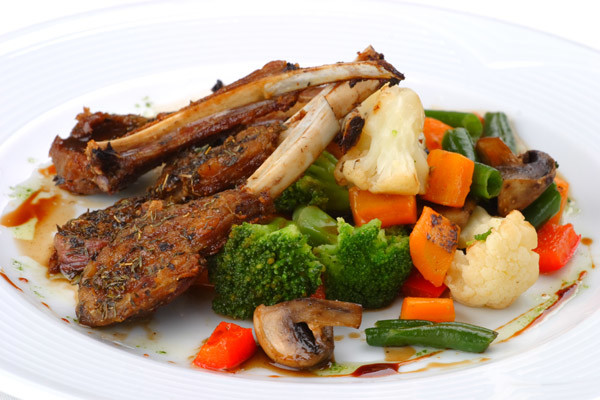 Don't grab the knife right away!The prepared leg should be kept in a warm place for half an hour - for example, wrapped in foil and put in the turned off oven with the door slightly open. Chefs say that this way the juices are distributed evenly throughout the meat and do not leak out when cutting. If you have a "manche-a-gigot" in your arsenal, screw the device onto the stump of the tibia (if not, just wrap the bone in a napkin or put a papillotte on it to make it easier to grip), lift it so that the leg is in a slightly inclined position, and cut the meat into thin slices with a sharp flexible knife almost parallel to the bone (some chefs cut evenly cooked meat along the bone, and rare meat - across and slightly diagonally). If you are unlucky and the butcher cuts off the tibia (and this is most often the case), then you will not be able to do without a long cutting fork and a wooden board. Claude Terraillat, the owner of the famous Parisian restaurant "Tour d'Argent", likes to repeat: "When you cook a leg of lamb, please improvise!" How can you disagree with him? Especially if we are talking about a festive table. Therefore, improvise not only when cooking, but also when serving.
Don't grab the knife right away!The prepared leg should be kept in a warm place for half an hour - for example, wrapped in foil and put in the turned off oven with the door slightly open. Chefs say that this way the juices are distributed evenly throughout the meat and do not leak out when cutting. If you have a "manche-a-gigot" in your arsenal, screw the device onto the stump of the tibia (if not, just wrap the bone in a napkin or put a papillotte on it to make it easier to grip), lift it so that the leg is in a slightly inclined position, and cut the meat into thin slices with a sharp flexible knife almost parallel to the bone (some chefs cut evenly cooked meat along the bone, and rare meat - across and slightly diagonally). If you are unlucky and the butcher cuts off the tibia (and this is most often the case), then you will not be able to do without a long cutting fork and a wooden board. Claude Terraillat, the owner of the famous Parisian restaurant "Tour d'Argent", likes to repeat: "When you cook a leg of lamb, please improvise!" How can you disagree with him? Especially if we are talking about a festive table. Therefore, improvise not only when cooking, but also when serving.
Deli board
You can have the leg of lamb without bones.In addition, a boneless leg can be stuffed. Another option: flatten it and then fry it like a huge steak. And of course, the leg can be cut into pieces - it is much easier to deal with them in a technical sense. Cooking a whole leg of lamb requires not so much imagination as precise knowledge of the technology, namely, how the weight of the piece correlates with the time of its heat treatment. The weight of lamb legs available on the market varies quite a lot depending on the country of origin of the meat. Thus, New Zealand ones can weigh from 2 to 2.5 kg, and domestic ones - from 3.5 to 4. If the leg is large, that is, more than 3.2 kg, it should be cooked based on the ratio of 10-13 minutes for every 450 g of weight. For a leg weighing up to 3.2 kg, the ratio is different: 8-9 minutes per 450 g. The recommended degree of roasting of a leg of lamb is medium. A leg of lamb contains three bones: the femur, the shank, and the pelvic bone (also sometimes called the ring bone). If you plan to cook it whole, ask the butcher to remove the pelvic bone, this will make it easier to cut into the cooked leg. If for some reason the butcher remains indifferent to your request, remove it yourself. Place the leg on a cutting board with the pelvic bone facing up. There may be a small bony protrusion sticking out from the side of the leg, shaped like a sickle - this is the caudal process. Cut it on all sides with a knife and break it off. The pelvic bone, as a rule, protrudes from the leg, it is large and has the shape of a blade. Start to free it by making cuts along its edge. In this case, the knife blade should be pressed against the bone. Continue until the joint appears. Then the pelvic bone should be lifted up and bent back, towards the leg. Bend it until the ball-and-socket joint comes out. Cut the tendons around and inside the joint, then remove the pelvic bone. It is recommended to skewer the cut meat with wooden skewers so that the leg cooks evenly. In addition to the bones, there are other inedible fragments in the leg of lamb: films and fat. They are what give lamb an unpleasant smell. They can be removed as follows. Take a knife and insert it under the layer of fat at the wide end of the leg. Move the knife from side to side, find the point where the fat separates from the meat in one piece. Take this fat flap with your hand and pull it upward, while cutting the film that attaches the fat to the meat with the knife. Try to touch only the film with the knife, not the meat. Carefully scrape off the remaining thin layer of fat, keeping the knife blade parallel to the meat. If the lamb is young, you can still leave a few strips of fat; if not, it is better to lard the leg or coat it with pork fat.
Leg of lamb braised with 40 cloves of garlic
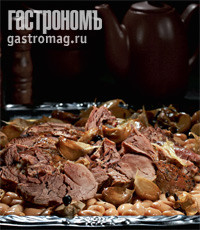
- 10 servings
What do you need
- 1 prepared leg of lamb weighing up to 3 kg
- 1 tsp salt
- 1 tsp freshly ground black pepper
- 1 tsp. Provencal herbs mixture
- extra virgin olive oil
- 40 unpeeled garlic cloves
- 8 sprigs of thyme
- 5 juniper berries
- 1 bottle of dry white wine
What to do Rub the leg with a mixture of salt, pepper andOlive herbs, grease with oil on all sides, cover the film loosely and put in the refrigerator overnight. The next day, get your foot out of the fridge, clean the solid marinade residues; Allow to warm to room temperature. Pour the oil in a refractory form with a layer of 2 cm, put on high heat for 3-4 minutes. Add the unpeeled garlic cloves, warm for 1 min. Place the leg in the roaster and fry it on all sides until golden brown, about 10 minutes. Remove the roaster from the fire, remove the meat and garlic, drain the fat, and, after cooling, wipe the pan slightly and dry it. Then put 4 thyme sprigs and half garlic cloves on the bottom of the roaster. Place a leg of lamb on top, scatter the remaining thyme and rosemary, garlic cloves and juniper berries around it. Pour the wine so that it covers the meat with a layer of at least 1 cm. Cover the roaster with a lid. Put in the oven, preheated to 130 ° C. Cook for 6 hours. Tip Lamb leg can be stewed not only in white wine, but also in red. Stronger drinks work well - dry and not very sherry, rum mixed with the same lamb broth and even brandy. Juniper gives the dish a specific game flavor, and if you don’t like it, just don’t put it on.
Baked Lamb Leg
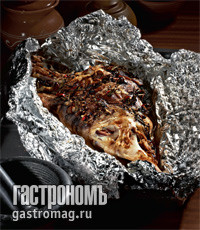
- 10 servings
What do you need
- 1 prepared leg of lamb weighing over 3.2 kg
- 1 tbsp freshly ground black pepper
- 2 small chili peppers
- 2 tsp salt
- 2 small sprigs of rosemary
- 3 cloves of garlic
- 3 tbsp extra virgin olive oil
What to do Stir black pepper with salt;rub the wide part of the leg (open part of the cut) half of the mixture. Peel the garlic, cut into long strips. Just chop the chili. Rosemary disassembled into leaves. In the meat, make 15–25 cuts with a knife about 1.5 cm deep and fill them with strips of garlic, chili and rosemary leaves. Grate the meat with oil and the remaining spices. Heat the oven to 230 ° C. In a refractory chafing dish, put the grate and put the leg on it with the fleshy side up. Put the mold in the oven and immediately reduce the temperature to 160 ° C. Cook for 1 hour and 15 minutes, depending on the size and desired degree of roasting. Wrap the prepared leg in foil and leave for 20 minutes. Tip The best way to determine the readiness of a large piece of meat is to use a special thermometer. It should be inserted into the thickest part of the preparing piece and leave for 5–6 minutes. In the case of a leg of lamb, a temperature of 51–54 ° C means that the lamb has reached the average degree of roasting with blood (in our opinion, this is exactly what is needed); 57–63 ° C - medium degree of roasting. Higher temperatures do not mean, of course, that the meat is gone, but its best taste, alas, will be lost.







